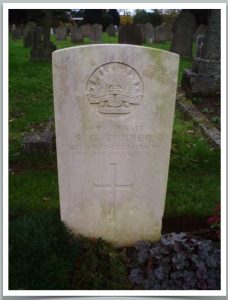53rd Battalion, Australian Infantry

Sydney George Turner was born in Sydney, New South Wales (NSW), Australia in 1891.
He was the son of Elizabeth Turner of Bates Street, Portland, NSW: his father was deceased at time of enlistment.
He had been an apprentice with the Commonwealth Cement Company and had moved on to become a mechanical engineer.
Having served for three years in the Senior Cadets, his first experience of military life was between 11 August 1914 and 28 January 1915, when he was part of a 2,000 strong volunteer force raised in Australia to seize and destroy the German wireless stations in German New Guinea.
This was to prevent their use by Vice-Admiral von Spee’s German East Asia Cruiser Squadron.
This was a successful operation and the territory (now Papua New Guinea) was occupied by Australia for the rest of the war.
On 20 November 1916 he re-enlisted at the Show ground in Sydney and joined ‘B’ Company, 9th Re-enforcement to the 53rd Battalion, Australian Infantry. The battalion was part of 14th Brigade of the 5th Australian Division.
He embarked for the UK on board HMAT Anchises on 24 January 1917 and during the voyage he spent the period 28 February to 2 March in Sick Bay suffering from influenza but had fully recovered by the time the ship arrived at Devonport on 27 March.
From there it was off to 14th Training Battalion at Hurdcott Camp, Wiltshire before transferring to the Parkhouse Military Camp at Shipton Bellinger in the same county.
On 16 May 1917 he crossed to Calais from Folkestone for his first experience of serving on the Western Front. His initial posting was to the Australian Veterinary Hospital at Calais but on 19 May he fell sick and was admitted to 30th General Hospital at Calais (nature of illness unknown).
He was discharged fit for duty on 25 May and rejoined the Veterinary Hospital staff on 2 June. He stayed until 14 October 1917, when he left for Base Depot at Le Havre, moving on to join up with 53 Battalion in the field on the 26th. The 5th Australian Division was engaged in the Second Battle of Passchendaele from this date to 10 November 1917 and this may have provided him with his first experience of action on the Western Front.
He appears to have come through this unscathed.
From 16 February to 9 March 1918 he was on leave in the UK. Having returned to the front he becameinvolved in the fight to stem the German advances of their Spring Offensive.
The battalion was located in defensive positions near to Villers-Bretonneux in the Somme sector.
On 18 April 1918 he was badly affected by mustard gas and arrived at 9th General Hospital, Rouen, via field ambulance, 12th Casualty Clearing Station and an ambulance train on 19 April.
Two days later he was on board the Hospital Ship Grantully Castle bound for England and was taken to St John’s VAD Hospital, Gloucester Road, Cheltenham.
He was one of 23 other Australians admitted that day, of whom 18 we suffering from the effects of mustard gas. The gas had obviously damaged his lungs and pneumonia had set in.
His condition was serious and his fiancée, a Miss Pallister, from Gateshead, near Newcastle travelled down to be with him. How this relationship had developed is not known. She was only able to stay for two days before having to return home for work.
On 2 May 1918 Private Turner’s condition continued to deteriorate and he died on that day, having had a visit from the Hospital Chaplain an hour or so before; he was aged 27.
Private Sydney George Turner was buried with full military honours in Cheltenham Cemetery at 2pm on 4 May 1918. Australian patients from St John’s Hospital mounted a guard of honour and provided bearers.
His fiancée Miss Pallister was in attendance along with the Gloucestershire Volunteer Regiment who provided a band, bugler and firing party.
News of his death was conveyed to his mother, now living at 202, Oxford Street, Paddington, Sydney.
His grave was later marked with a standard CWGC headstone.
Research by Graham Adams 4 March 2013
